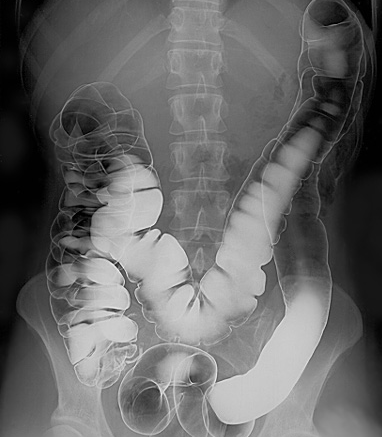Barium enema examination
Peer reviewed by Dr Toni Hazell, MRCGPLast updated by Dr Colin Tidy, MRCGPLast updated 23 Aug 2023
Meets Patient’s editorial guidelines
- DownloadDownload
- Share
- Language
- Discussion
Medical Professionals
Professional Reference articles are designed for health professionals to use. They are written by UK doctors and based on research evidence, UK and European Guidelines. You may find the Barium enema article more useful, or one of our other health articles.
In this article:
Continue reading below
What is a barium enema examination?
A barium enema is a rectal injection of barium contrast. This coats the lining of the colon and rectum and X-ray films are obtained under fluoroscopic control. Air introduced into the large bowel may be used to give a double-contrast technique. Barium enemas are performed much less often than in the past because of the increasing use of colonoscopy and CT colonography.
A small bowel barium enema refers to the use of a specially designed tube passed nasally and into the duodenojejunal flexure under fluoroscopic control, after which dilute barium is infused via the tube until it reaches the terminal ileum in continuous flow. It is used to investigate suspected small bowel disease (eg, Crohn's disease, lymphoma) and malabsorption (eg, coeliac disease). It is an unpleasant procedure for the patient and is often now replaced by CT or ultrasound where possible.
This rest of this article refers to barium enema as used in the large bowel.
Intestinal tract barium enema

By Glitzy queen00 at English Wikipedia., Public domain, via Wikimedia Commons
Indications
To assess the anatomy of the large bowel and occasionally the terminal ileum.
Abnormalities detected include large bowel obstruction, tumours, ulcers, diverticular disease, inflammatory bowel disease, intussusception, Hirschsprung's disease and thickening of the lining of the colon or rectum.
A barium enema is not reliable for the diagnosis of rectal pathology.
Therapeutic uses
Conservative treatment with barium, air or saline enema is often effective in children who present with intussusception, unless diagnosis and treatment are delayed.
Barium enema may be effective in reducing large bowel volvulus in children but resection of the involved segment and primary anastomosis is the definitive treatment.
Refractory bleeding colonic diverticulae: high-dose barium enema is as effective as endoscopic haemostasis for the prevention of recurrent diverticular bleeding.1
Continue reading below
Cautions and possible complications
Barium enema is uncomfortable for the patient and requires good patient mobility and co-operation. More patients find the procedure embarrassing than do patients having colonoscopy or CT colonography.2 It should not be requested for frail elderly patients unless there is a clear indication.
A rectal examination or sigmoidoscopy is essential to avoid missing abnormalities.
Radiation exposure is relatively low.
The barium enema is a relatively safe procedure. Rare complications include:3
Bowel perforation:
Occurs in between 2-4/10,000 patients, usually related to iatrogenic trauma from catheter placement.
Pre-existing diseased bowel is more likely to perforate than normal healthy bowel.4
The mortality rate associated with intraperitoneal perforation is high due to the combination of barium and bacterial load which causes acute peritonitis and shock.
Barium impaction - causes large bowel obstruction.
Water intoxication.
Allergic reactions.
Cardiac arrhythmias.
Prevention of endocarditis
Currently, antibacterial prophylaxis is not recommended for the prevention of endocarditis in those undergoing radiological procedures involving their lower gastrointestinal tract.5 Any infection in patients at risk of endocarditis should be investigated and treated promptly to reduce the risk of endocarditis. Patients at risk of endocarditis should be educated as to the signs of infective endocarditis and told to seek expert advice if these occur.
Contra-indications
Allergy to the latex balloon on the tip of enema tube (rare).
Severe rectal inflammation or recent rectal biopsy (delay for seven days after a full-thickness biopsy). Patients with active colitis should not have a barium enema.
Acute gastrointestinal bleeding (precludes the use of angiography).
Pregnancy: X-rays of the abdomen and pelvis should be avoided.
Continue reading below
Preparation and procedure
Low-residue diet for three days prior to the procedure and laxatives 24 hours before.
Nil by mouth after midnight.
Bowel washout immediately prior to procedure.
Antispasmodic (eg, hyoscine butylbromide) may be given to minimise spasm.
The patient lies on their side and an enema tube is inserted into the rectum.
Barium is run into the colon under gravity and radiographs are taken. Air is also then introduced into the rectum for a double-contrast barium enema.
Further reading and references
- Fujimoto A, Sato S, Kurakata H, et al; Effectiveness of high-dose barium enema filling for colonic diverticular bleeding. Colorectal Dis. 2011 Aug;13(8):896-8. doi: 10.1111/j.1463-1318.2010.02350.x. Epub 2010 Jun 10.
- Von Wagner C, Knight K, Halligan S, et al; Patient experiences of colonoscopy, barium enema and CT colonography: a Br J Radiol. 2009 Jan;82(973):13-9. Epub 2008 Sep 29.
- de Feiter PW, Soeters PB, Dejong CH; Rectal perforations after barium enema: a review. Dis Colon Rectum. 2006 Feb;49(2):261-71.
- Yasar NF, Ihtiyar E; Colonic perforation during barium enema in a patient without known colonic Cases J. 2009 Aug 14;2:6716.
- Prophylaxis against infective endocarditis: Antimicrobial prophylaxis against infective endocarditis in adults and children undergoing interventional procedures; NICE Clinical Guideline (March 2008 - last updated July 2016)
Continue reading below
Article history
The information on this page is written and peer reviewed by qualified clinicians.
Next review due: 21 Aug 2028
23 Aug 2023 | Latest version

Ask, share, connect.
Browse discussions, ask questions, and share experiences across hundreds of health topics.

Feeling unwell?
Assess your symptoms online for free